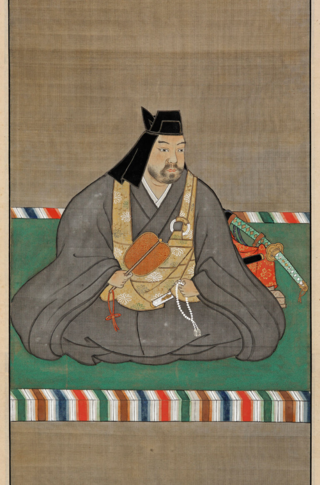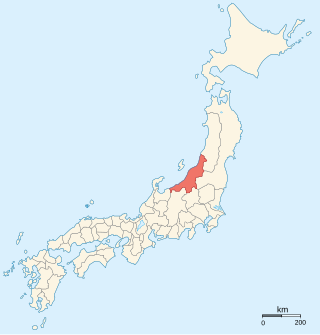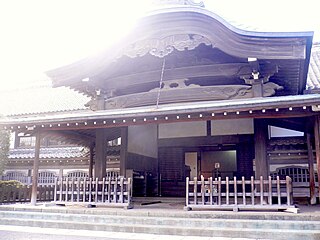
Niigata Prefecture is a prefecture in the Chūbu region of Honshu of Japan. Niigata Prefecture has a population of 2,131,009 and is the fifth-largest prefecture of Japan by geographic area at 12,584.18 km2 (4,858.78 sq mi). Niigata Prefecture borders Toyama Prefecture and Nagano Prefecture to the southwest, Gunma Prefecture to the south, Fukushima Prefecture to the east, and Yamagata Prefecture to the northeast.

Ryōtsu was a city located in Sado Island, Niigata Prefecture, Japan.
This is a list of Japanese clans. The old clans (gōzoku) mentioned in the Nihon Shoki and Kojiki lost their political power before the Heian period, during which new aristocracies and families, kuge, emerged in their place. After the Heian period, the samurai warrior clans gradually increased in importance and power until they came to dominate the country after the founding of the first shogunate.

Nagao Kagetora, later known as Uesugi Kenshin was a Japanese daimyō. He was born in Nagao clan, and after adoption into the Uesugi clan, ruled Echigo Province in the Sengoku period of Japan. He was one of the most powerful daimyō of the Sengoku period. Known as the "Dragon of Echigo", while chiefly remembered for his prowess on the battlefield as a military genius, Kenshin is also regarded as an extremely skillful administrator who fostered the growth of local industries and trade and his rule saw a marked rise in the standard of living of Echigo.

Sado Province was a province of Japan until 1871; since then, it has been a part of Niigata Prefecture. It was sometimes called Sashū (佐州) or Toshū (渡州). It lies on the eponymous Sado Island, off the coast of Niigata Prefecture.

Sanada Masayuki was a Japanese Sengoku period lord and daimyō. He was the head of Sanada clan, a regional house of Shinano Province, which became a vassal of the Takeda clan of Kai Province. Along with his father and brothers, Masayuki served the Takeda clan during its heyday, when it was led by Takeda Shingen. After its downfall, Masayuki took the lead of his clan and, despite little power, he managed to establish himself as an independent daimyō under the Toyotomi regime through skillful political maneuvers amidst the powerful Tokugawa, Hojō and Uesugi clans.

Echigo Province was an old province in north-central Japan, on the shores of the Sea of Japan. It bordered on Uzen, Iwashiro, Kōzuke, Shinano, and Etchū Provinces. It corresponds today to Niigata Prefecture, minus the island of Sado.

Sado is a city located on Sado Island in Niigata Prefecture, Japan. Since 2004, the city has comprised the entire island, although not all of its total area is urbanized. Sado is the sixth largest island of Japan in area following the four main islands and Okinawa Island. As of June 1, 2023, the city has an estimated population of 48,195 and a population density of 56.3 inhabitants per square kilometre (146/sq mi). The total area is 855.69 square kilometres (330.38 sq mi).

Sado Island is an island located in the eastern part of the Sea of Japan, under the jurisdiction of Sado City, Niigata Prefecture, Japan, with a coastline of 262.7 kilometres (163.2 mi). In October 2017, Sado Island had a population of 55,212 people. Sado Island covers an area of 854.76 km2 (330.02 sq mi), and is the second largest island after Okinawa Island outside of the four main islands of Japan, excluding the disputed Southern Kurils. The shortest distance between Sado Island and Honshu is 32 km (20 mi). The highest peak on Sado Island is Mount Kinpoku, with an elevation of 1,172 m (3,845 ft).

Nagao clan was a Japanese samurai clan.

Uesugi Norimasa was a daimyō of feudal Japan from Yamanouchi branch Uesugi clan and held the post of Kantō Kanrei, the shōgun's deputy in the Kantō region. He was the adoptive father of Uesugi Kenshin, one of the most famous warlords in Japanese history.

The Takeda Clan was a Japanese samurai clan active from the late Heian period until the late 16th century. The clan was historically based in Kai Province in present-day Yamanashi Prefecture. The clan reached its greatest influence under the rule of Takeda Shingen, one of the most famous rulers of the period.

The Uesugi clan is a Japanese samurai clan which was at its peak one of the most powerful during the Muromachi and Sengoku periods. At its height, the clan had three main branches: the Ōgigayatsu, Inukake, and Yamanouchi. Its most well-known member is the warlord Uesugi Kenshin (1530–1578).

The 1545–1546 Siege of Kawagoe Castle was part of a failed attempt by the Uesugi clan to regain Kawagoe Castle from the Later Hōjō clan in the Sengoku period of Japan. Uesugi Tomosada of the Ogigayatsu branch of the Uesugi clan attacking Kawagoe castle, he was joined by his more powerful relative Uesugi Norimasa from Yamanouchi branch Uesugi clan, who held the post of Kantō Kanrei, the shōgun's deputy in the Kantō region by Ashikaga Haruuji, the Kantō kubō in Koga, and by a host of anti-Hōjō daimyō from the Kantō region.

Hōjō Ujiyasu was a daimyō (warlord) and third head of the Odawara Hōjō clan. Known as the "Lion of Sagami", he was revered as a fearsome warrior and a cunning man. He is famous for his strategies of breaking the siege from Takeda Shingen and Uesugi Kenshin. A son of Hōjō Ujitsuna, his only known wife was Imagawa Yoshimoto's sister, Zuikei-in. Among his sons are Hōjō Ujimasa and Uesugi Kagetora.

Kawagoe Castle is a flatland Japanese castle in the city of Kawagoe, in Japan's Saitama Prefecture. It is the closest castle to Tokyo to be accessible to visitors, as Edo castle is now the Imperial palace, and largely inaccessible.
Honma or Homma is a Japanese surname. The choice of spelling for particular historical and modern persons is arbitrary.

Watatsu Shrine is a Shinto shrine in the Hamochiiioka neighborhood of the city of Sado, Niigata. It is the ichinomiya of former Sado Province. The main festival of the shrine is held annually on the April 23.

The Sado gold mine is a generic term for gold and silver mines which were once located the island of Sado in Niigata Prefecture, Japan. Among these mines, the Aikawa Gold and Silver Mine was the largest and was in operation until the modern era. The Sado Gold and Silver Mine was inscribed on Japan's World Heritage Tentative List under the title "The Sado Complex of Heritage Mines, Primarily Gold Mines" in 2010.

Lady Shirai was a Japanese noble lady and aristocrat from the Sengoku period. She was born to the Nagao clan in Shirai, who were head retainers to the Uesugi clan in Kantō. She was the wife of Narita Nagayasu, the lord of Oshi castle in Musashi. She is also thought to be either the daughter or granddaughter of Nagao Kageharu. Lady Shirai was a retainer of the Ashikaga Shogunate, fought and died during the Incident of Kyoto in 1565, when Ashikaga Yoshiteru was killed.

















